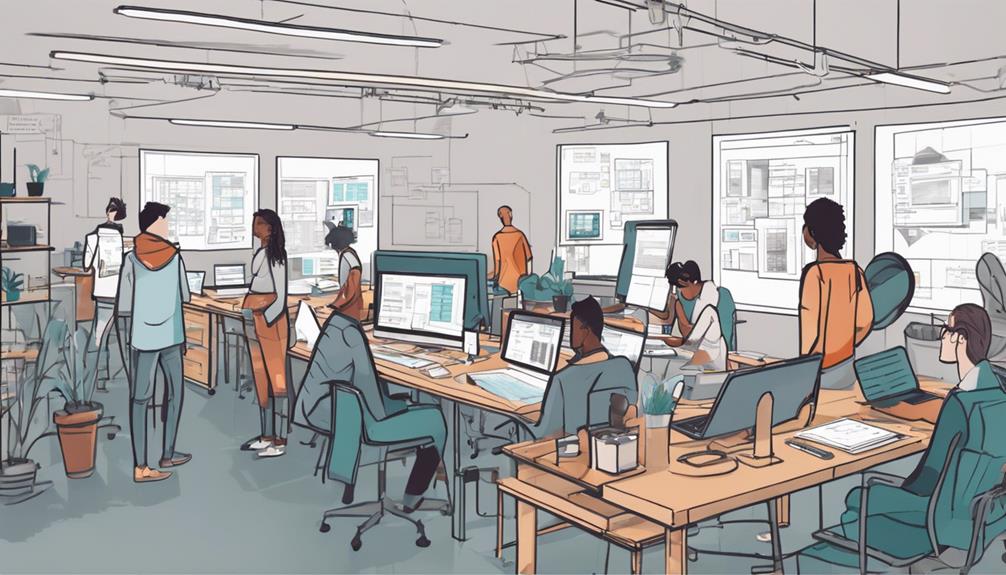Explore the 5th edition of 'Interaction Design: Beyond Human-Computer Interaction' for a thorough guide on user-centered principles, designing for diversity, prototyping, usability testing, and integrating advanced technologies ethically. Discover essential concepts and frameworks, along with insights into evolving trends and responsible design practices. This edition examines the evolving landscape of interaction design, offering valuable knowledge on creating innovative and inclusive user experiences that prioritize user feedback and ethical considerations. Engage with the key principles and emerging trends in interaction design for a more informed approach to designing interactive systems.
Key Takeaways
- Comprehensive coverage of interaction design principles.
- Insights into designing for various platforms and contexts.
- Emphasis on user-centered design and usability testing.
- Exploration of future trends and advanced technologies.
- Integration of ethics and responsibility in design practices.
Evolution of Interaction Design

As you explore the evolution of interaction design, you'll uncover its dynamic journey from its inception to the present day. Looking back at the historical perspective of interaction design, you'll find that it has evolved considerably over the years. Initially focused on improving user interfaces for digital products, interaction design has expanded to encompass a broader range of experiences and technologies.
In the past, interaction design mainly revolved around enhancing the usability and functionality of websites and software applications. However, with the rise of mobile devices, virtual reality, and artificial intelligence, the scope of interaction design has expanded to include a variety of platforms and contexts.
As technology continues to advance, future trends in interaction design point towards more personalized and immersive experiences for users. Designers are now incorporating elements like voice interfaces, gesture controls, and adaptive interfaces to create more intuitive and engaging interactions.
Key Concepts and Frameworks
Exploring fundamental principles and structures is important for understanding the essence of interaction design. Design thinking plays a significant role in shaping user experience by focusing on creating innovative solutions that resonate with users. Accessibility is a critical concept that promotes inclusive design practices, making products usable by individuals with diverse abilities. User research forms the foundation of interaction design, allowing designers to gain insights into user behaviors, preferences, and needs, which are essential for creating user-centered solutions.
Frameworks such as the Double Diamond model guide designers through the divergent and convergent stages of problem-solving, emphasizing the importance of exploration and refinement. The Technology Acceptance Model (TAM) helps designers understand user acceptance of technology, influencing design decisions to enhance user experience.
These frameworks provide a structured approach to designing interactive systems that are both functional and user-friendly, ultimately leading to more successful design outcomes.
User-Centered Design Principles

Understanding user-centered design principles is key to creating interactive systems that prioritize user needs and preferences. By incorporating user feedback and conducting usability testing throughout the design process, you guarantee that the final product meets user expectations and enhances their overall experience.
User feedback plays a pivotal role in user-centered design, providing valuable insights into how users interact with the system and what improvements can be made. By actively seeking and incorporating feedback, you can tailor the design to better suit the users' needs and preferences.
Usability testing is another essential aspect of user-centered design, allowing you to evaluate the system's ease of use and effectiveness. By observing users as they interact with the system, you can identify any usability issues and make informed design decisions to enhance the overall usability of the system.
Incorporating user feedback and conducting usability testing are fundamental principles of user-centered design that ensure interactive systems are intuitive, effective, and user-friendly.
Designing for Diversity and Inclusion
Consider incorporating principles of diversity and inclusion into your design process to guarantee that interactive systems cater to a wide range of users.
Designing for diversity and inclusion involves creating accessible interfaces that are culturally sensitive to different user groups. Inclusive design aims to empower users by ensuring that interactive systems are usable by everyone, regardless of their background or abilities.
When implementing accessible interfaces, you should consider factors such as visual impairments, motor disabilities, and cognitive differences to make your design more inclusive.
Cultural sensitivity plays an essential role in understanding the diverse needs and preferences of users from various cultural backgrounds. By embracing inclusive design practices, you can create interactive systems that promote user empowerment and enhance the overall user experience.
Remember that designing for diversity and inclusion isn't just about meeting basic accessibility standards; it's about fostering a welcoming and inclusive environment for all users.
Prototyping and Iterative Design

To improve your design process, start by creating interactive prototypes that allow for rapid prototyping and user feedback. Interactive prototypes are invaluable tools that help you visualize your design ideas and gather valuable insights from users early in the design process.
By creating prototypes that users can interact with, you can quickly test different features, interactions, and interfaces to see what works best. Rapid prototyping enables you to iterate on your designs quickly, making necessary adjustments based on user feedback. This iterative design approach allows you to refine your solutions continuously, ensuring that you create a user-friendly and effective product.
User feedback plays an essential role in this process, as it provides you with valuable information on what aspects of your design are working well and what areas need improvement.
The Role of Information Architecture
Explore how information architecture shapes the organization and accessibility of content within a digital interface. Information organization is the foundation of a seamless user experience, ensuring that users can easily navigate and find the content they seek.
By strategically mapping out the structure of information within a digital interface, you can enhance user experience mapping and guide users through a logical flow of content.
Effective information architecture involves categorizing information in a clear and intuitive manner, creating pathways that lead users to their desired destination efficiently. Through thoughtful organization, users can easily understand the relationships between different pieces of content and navigate the interface with ease.
User experience mapping plays an important role in information architecture, as it helps designers visualize the user journey and understand how information should be structured to best meet user needs.
Implementing Usability Testing

Implementing usability testing is an essential step in ensuring the effectiveness of a digital interface in meeting user needs and expectations. To conduct successful usability testing, begin by defining clear usability metrics that align with the goals of the interface.
Next, focus on participant recruitment, ensuring a diverse pool of users representative of your target audience.
When designing task scenarios for usability testing, remember to create realistic and relevant tasks that will allow users to interact with the interface in a meaningful way. These scenarios should test the interface's functionality, navigation, and overall user experience.
During usability testing sessions, encourage participants to provide candid user feedback. Their insights can uncover usability issues that may not be apparent through quantitative data alone.
User feedback is invaluable in identifying areas for improvement and refining the interface to better meet user expectations. By incorporating usability testing into your design process, you can create a digital interface that's user-friendly, intuitive, and aligned with user needs.
Designing for Emerging Technologies
When considering designing for emerging technologies, anticipate how these advancements will shape user interactions and experiences in the future. As new technologies like virtual reality, artificial intelligence, and Internet of Things continue to evolve, it's essential to stay ahead of the curve in understanding their potential impact on design.
Future trends suggest that immersive experiences, personalized interactions, and seamless integrations will become more prevalent in user interfaces.
Incorporating these advancements into your design process requires not only technical knowledge but also an awareness of the ethical implications involved. Designers must consider issues such as data privacy, algorithmic bias, and accessibility when creating products for these emerging technologies.
Balancing innovation with ethical considerations is key to building trust with users and ensuring responsible design practices.
Ethics and Responsibility in Design

Consider the ethical implications of your design decisions to promote responsible and socially conscious practices in the field of interaction design. When designing interactive systems, it is important to prioritize ethical considerations and understand the potential social impact of your work. By integrating ethical principles into your design process, you can guarantee that your creations benefit society as a whole.
To emphasize the importance of ethical considerations in design, let's take a look at the following table:
| Ethical Considerations | Social Impact |
|---|---|
| User Privacy | Increased Trust |
| Accessibility | Inclusivity |
| Data Security | Protection of Information |
| Transparency | Accountability |
| Fairness | Equity in Access |
Conclusion
In general, 'Interaction Design Beyond Human-Computer Interaction' offers an extensive overview of key concepts, frameworks, and principles in the field of interaction design.
From user-centered design to prototyping and usability testing, the book provides valuable insights into designing for diverse audiences and emerging technologies.
With a focus on ethics and responsibility, this edition serves as a practical guide for those looking to create inclusive and user-friendly digital experiences.




